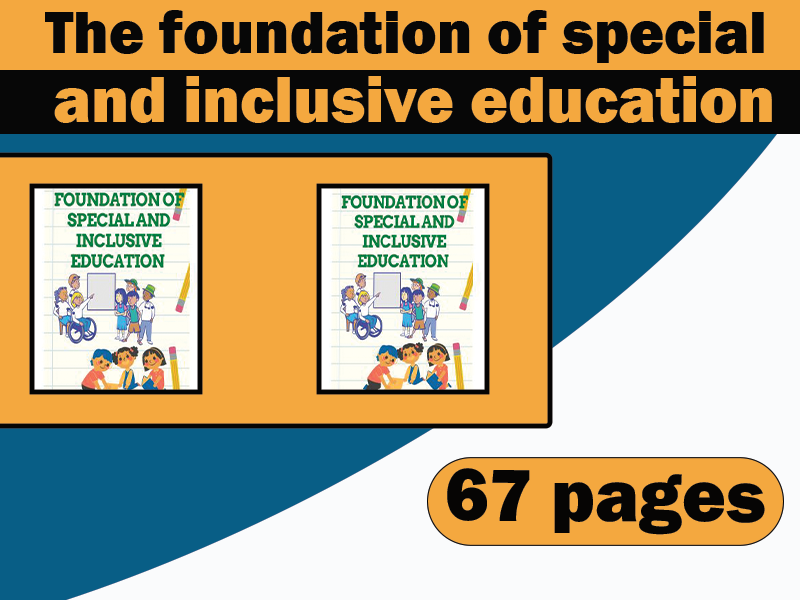31Uploads
546Views
24Downloads
Special educational needs

foundation-of-special-and-inclusive-education
This resource provides a brief overview of the “Foundations of Special and Inclusive Education,” emphasizing that this field aims to provide equal educational opportunities for all students, particularly those with disabilities. Inclusive education is based on the principle that every child has the right to receive a high-quality education in a supportive environment, regardless of their abilities or challenges. This approach not only benefits students with disabilities but also enriches the learning experience for all students by promoting diversity, empathy, and collaboration.
Historically, students with disabilities were often segregated in special institutions. However, changing societal attitudes and understandings of disability have led to the emergence of movements supporting the rights of individuals with disabilities. Key laws, such as the Individuals with Disabilities Education Act (IDEA) in the United States and the Convention on the Rights of Persons with Disabilities (CRPD) internationally, have paved the way for inclusive education.

ASL Fingerspelling Chart: Printable Reference
The A-Z Handshapes in American Sign Language is a comprehensive visual resource designed to teach basic handshapes in American Sign Language. Understanding these shapes is crucial for effective communication in American Sign Language, as they form the foundation of signs and expressions. This resource is ideal for beginners, teachers, and anyone looking to improve their ASL skills.
The Importance of Handshapes in American Sign Language
Handshapes are the foundation of American Sign Language, enabling the expression of words, ideas, and feelings. Each handshape represents specific letters, words, or concepts, and mastering them is essential for effective communication. Recognizing and accurately reproducing these shapes enhances clarity and fluency in the use of signs.
A-Z Handshapes Overview
The guide provides a detailed description of each handshape for the letters A-Z, along with examples of signs that use this shape. For example:
A: A closed fist with the thumb next to the index finger. A: A closed fist with the thumb next to the index finger. B: An open hand with straight, interlocked fingers and the thumb tucked into the palm.
C: A “C” shape formed by strengthening the fingers and thumb.
D: The index finger extended with the remaining fingers tucked into the palm.
The guide explains each letter of the alphabet, showing the corresponding hand shape in American Sign Language.
Sale

Communication Basics for Children with Special Needs
Summary: Communication Basics for Children with Special Needs
The “Communication Essentials for Children with Special Needs” guide is a comprehensive resource for parents, teachers, and caregivers, designed to empower children who face communication difficulties. The guide emphasizes the importance of communication as a fundamental skill for self-expression and interaction.
Understanding communication challenges
Children with special needs face various communication challenges, such as:
Speech delay: difficulty producing sounds and forming words.
Language disorders: difficulty understanding or using language appropriately.
Social communication challenges: Difficulty participating in conversations and understanding social cues (especially in people with autism).
Nonverbal communication: Relying on gestures, facial expressions, or alternative methods of communication.
Key strategies for effective communication
The guide provides practical strategies for improving communication:
Use clear, simple language: short, direct sentences and avoid complex vocabulary.
Visual support: Use pictures, symbols, and communication boards to enhance understanding.
Modeling Communication: Demonstrate effective communication skills through appropriate language and a calm tone.
Encourage interaction: Provide opportunities for the child to connect with others through play and group activities.
Be patient and give time: Give the child enough time to process the information and respond.
Use positive reinforcement: Celebrate and encourage attempts to communicate.
Integrate technology: Explore assistive devices such as speech-generating devices and apps for communication.
Activities to support communication development
The guide suggests various activities to enhance communication skills:
Story time: Read books with repetitive language and encourage the child to point and describe what he sees.
Role-playing: practicing social interactions in different scenarios.
Picture Exchange Communication System (PECS): Using pictures to communicate wants and needs, it is especially useful for non-verbal children.
Interactive games: Play games that require communication, such as “Simon Says” or “I Spy.”
Create a daily communication log: Encourage your child to draw or write about their day as a means of self-expression.
This guide aims to provide parents, teachers, and caregivers with the tools and strategies needed to help children with special needs communicate effectively.



